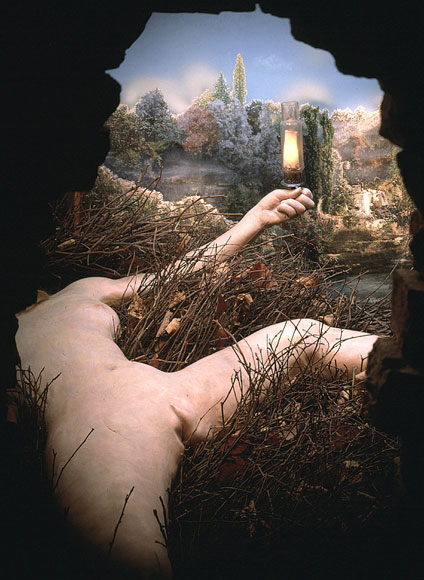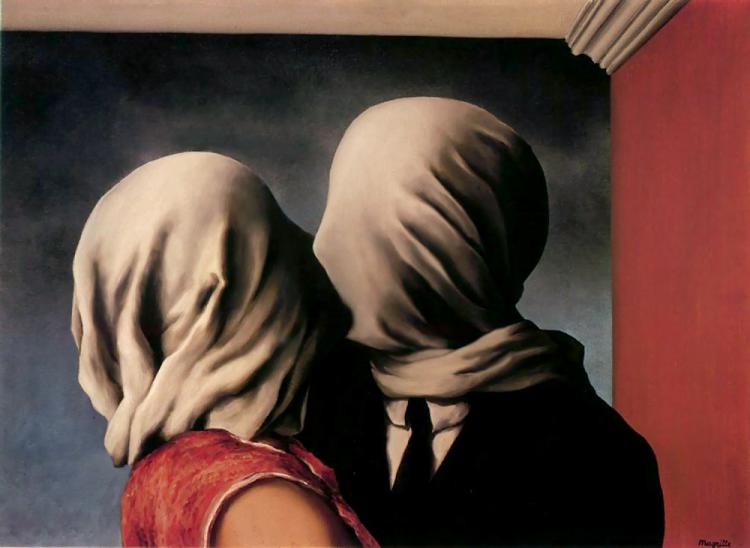I am still absorbing Saturday night. But I want to record some thoughts here, before the paint dries, if you will.
I don't know how many of those who were there on Saturday got to see the "installation" in the back of the back room - What looked like a woman bent over a knocked over chair - her legs bound up with twine, or rope - her underwear pulled aside. It looked like a crime scene, or a surrealist photograph. It was strangely beautiful, and upsetting.
That body was Julie Tolentino's. (Most of the photographs of the event were taken by Tracy Mostovoy. The image below - to the left of Duchamp & Sherman - was, however, taken by E.O.) She


describes this w

ork a "study," produced in collaboration with Stosh Fila. Both the image presented, and its positioning in the back of the room, tucked away, slightly hidden - reminded me of Marcel Duchamp's
Étant Donnés (1944-1966). The title means "given" - as in "a given," and is installed at the Philadelphia Museum of Art. I believe this was his last work or, at least, it was exhibited only after his death. It, too, is an installation of sorts - in order to see this image you have to look through a peephole - your curiosity is "rewarded" with the image of what looks like a nude female corpse. I think it is the "givenness" of the image that connects the two works for me - the idea that this violated body is
always already there.
It seemed, too, to ask why we were all there. In an e-mail correspondence Tolentino mentioned
Cindy Sherman as a point of reference - and she certainly invoked those
"crime scene" images which are beautiful, abject, sexual and disturbing all at the same time. And, like Sherman, Tolentino is working with her body here. What does it mean for an artist to present herself
live, in such a position?

The crowd drifted towards that back corner of the back room - sensing that this room - which held two large platforms-plympths - was where the action would be. And as we looked at this "picture" (it was a kind of tableaux vivant if you can have what looks like a violated corpse at the heart of a living picture), we were gently encouraged into the front room - where we found Heather Cassils on the bar in a V-shaped posing thong (I am not sure if that's the right terminology for what she was wearing). Her back was to us, and she was posing as would a body builder - but straining, vibrating with tension.


Tolentino's body was a beautiful corpse, a scene of sexual violence and disaster - totally still, exposed and yet hidden (we could only see her lower half, from the back).
Walking into the main room we were confronted with a different body. Where Tolentino's was low, hidden in the dark - Cassils's was high up on the bar, back lit, and glowing. It was
still, in that her movement was very minimal - but the performance was very much alive - she quivered, rippled, and
ripped. (This is perhaps the performance most difficult photograph - how to capture
quivering in a still image??)
I don't have the word for her version of gender fuck. Androgynous does not seem quite right somehow. Maybe some of you can help me on this.
She moved carefully through a posing sequence - these movements choreographed with lighting changes which seemed to draw her outline in electricity. As she turned toward the crowd, she presented a face marred, scarred across the eyes - a mask, a mess of pink flesh and glitter (could she see anything?) It took me a while to notice that her feet were slippered in panty-hose like fabric, and that it must have been very slippery up there. I found myself anxious, nervous, and stunned by the strange simplicity of it all. She calls the piece "Hard Times." It was beautiful, and strange.
The crowd was then directed gently to the back room for Tolentino's performance "Cry of Love." I'll wait to write about this piece in a separate entry, because already there is so much to think about: The whole night felt like a conversation between the artists - something I watched Ron Athey & Julie Tolentino knit together over the weekend - and especially the latter as she also made magic with the minimalist technical set up, and orchestrated the sequence of performances in order to make the most of the space and create the right pacing. One might, in this sense, say she wrote and "scored" the evening (my colleague
Jim Tobias uses this term in an expanded sense that I find really useful for talking about performance).
Pairing the "hidden" opening image with Cassils's performance was itself fascinating - two extreme presentations - "studies" to borrow Tolentino's framing - of the female body - working very differently in their resistance to, explosions/implosions of that that term "female body" might mean. I appreciated opening a night of queer performance with such strong and radically different feminist images. And the physical geometry, too - they were positioned at opposite ends of the space. Like a performative frame. We turned our backs on Julie to see Heather. That's important. Turning around, facing, turning away from - there was a lot of this kind of movement both within the performances, and in the audience. That movement served very practical purposes, allowing the artists to get into their positions while the audience's attention was directed elsewhere. That said, I've never seen an audience's movement, in fact, so perfectly integrated into the experience of a performance. It seemed to amplify each piece, make each performance feel in and of itself like a movement.
I read that as one of Julie Tolentino's signatures on the evening - a consciousness of the meaningfulness of the movement of our bodies through the performative space. More on this later.



 Above are three of Tracy Mostovoy's photographs of Julie Tolentino's performance "Cry of Love." Tolentino's face is wrapped in coarse rope which extends from her, across and above the audience. Stosh Fila stands discreetly behind the crowd holding the other end, and pulls. Tolentino unravels before us, rolling over, spinning, being spun. She unwinds. I imagine that the rope ends in her mouth. It is an incredibly simple image. Again I'm reminded of the surrealists, this time: Magritte - like The Lovers, pictured here.
Above are three of Tracy Mostovoy's photographs of Julie Tolentino's performance "Cry of Love." Tolentino's face is wrapped in coarse rope which extends from her, across and above the audience. Stosh Fila stands discreetly behind the crowd holding the other end, and pulls. Tolentino unravels before us, rolling over, spinning, being spun. She unwinds. I imagine that the rope ends in her mouth. It is an incredibly simple image. Again I'm reminded of the surrealists, this time: Magritte - like The Lovers, pictured here. I am thinking of that fairy tale about the two princesses, one who spits roses and diamonds when she speaks, and one who spits frogs and toads. I am thinking about how my love seems to love my talk, and doesn't seem to mind when I bore him. The talk is like a cord, a connection. Something is traveling along it besides sense. And I think of my own dreams, in which I hear my love's voice - no words that I understand, just sound - something from the mouth. (That my thoughts on this become about me reflect how personal this performance feels - not only for the artist, but for her audience.)
I am thinking of that fairy tale about the two princesses, one who spits roses and diamonds when she speaks, and one who spits frogs and toads. I am thinking about how my love seems to love my talk, and doesn't seem to mind when I bore him. The talk is like a cord, a connection. Something is traveling along it besides sense. And I think of my own dreams, in which I hear my love's voice - no words that I understand, just sound - something from the mouth. (That my thoughts on this become about me reflect how personal this performance feels - not only for the artist, but for her audience.)












